Roman-style tripe
- Easy
- 1 h 35 min


Coda alla vaccinara is a delicious main course from Roman cuisine. Its origin can be traced back to the taverns of the old Roman district where butchers (Vaccinari) lived. They were once paid for their services with the 'fifth quarter,' which included the less prized parts of the animals such as tripe, oxtail, and other offal. These butchers, in turn, sold the scraps to the common people who couldn't afford the more noble cuts. Dishes like coda alla vaccinara, Roman tripe, and the typical rigatoni with pajata were born out of this popular cuisine, with the aim of making the most of even the poorest ingredients, turning necessity into virtue. These recipes are still enjoyed today, thanks to their simple goodness that has made them timeless on our tables. The recipe here was prepared for us by Claudio and Fabrizio Gargioli of Armando al Pantheon, a historic restaurant in the heart of Rome that has helped to pass down these traditional dishes. Coda alla vaccinara is a succulent and rustic dish: proof that the cuisine of the past remains the best!

To prepare coda alla vaccinara, cut the oxtail at the joints with a suitable knife to obtain pieces about 2-3 inches long 1. In a pan, sauté the ham fat with a drizzle of oil 2. Add the oxtail 3.

Salt 4 and season with garlic 5 and chopped onion 6.

Add the cloves 7. Pour in the wine 8 and, once evaporated, cook for 10 minutes over high heat with the lid on. Add the canned tomatoes 9, still on high heat.

Add water to cover, if necessary 10, and mix well. Then cook for 2-3 hours over high heat 11 with the lid on. Check from time to time and stir; if the sauce reduces too much, add more water. Meanwhile, prepare the celery sauce: soak the raisins in cold water 12.

Cut off the green leaves of the celery 13, chop it into pieces 14, and then use a paring knife to remove the outer strands 15.

Boil the celery in boiling water for 10-15 minutes 16, just long enough to soften it 17. Blend the celery with a little cooking water using an immersion blender 18.

Season with grated dark chocolate 19. Then add the drained raisins 20 and pine nuts 21.

Add a ladle of cooking sauce 22 and mix 23. Pour the sauce into the pan and finish cooking 24.

The coda alla vaccinara will be ready when the meat is tender but not falling apart 25. Adjust the salt and serve 26 with toasted breadcrumbs in a pan 27.